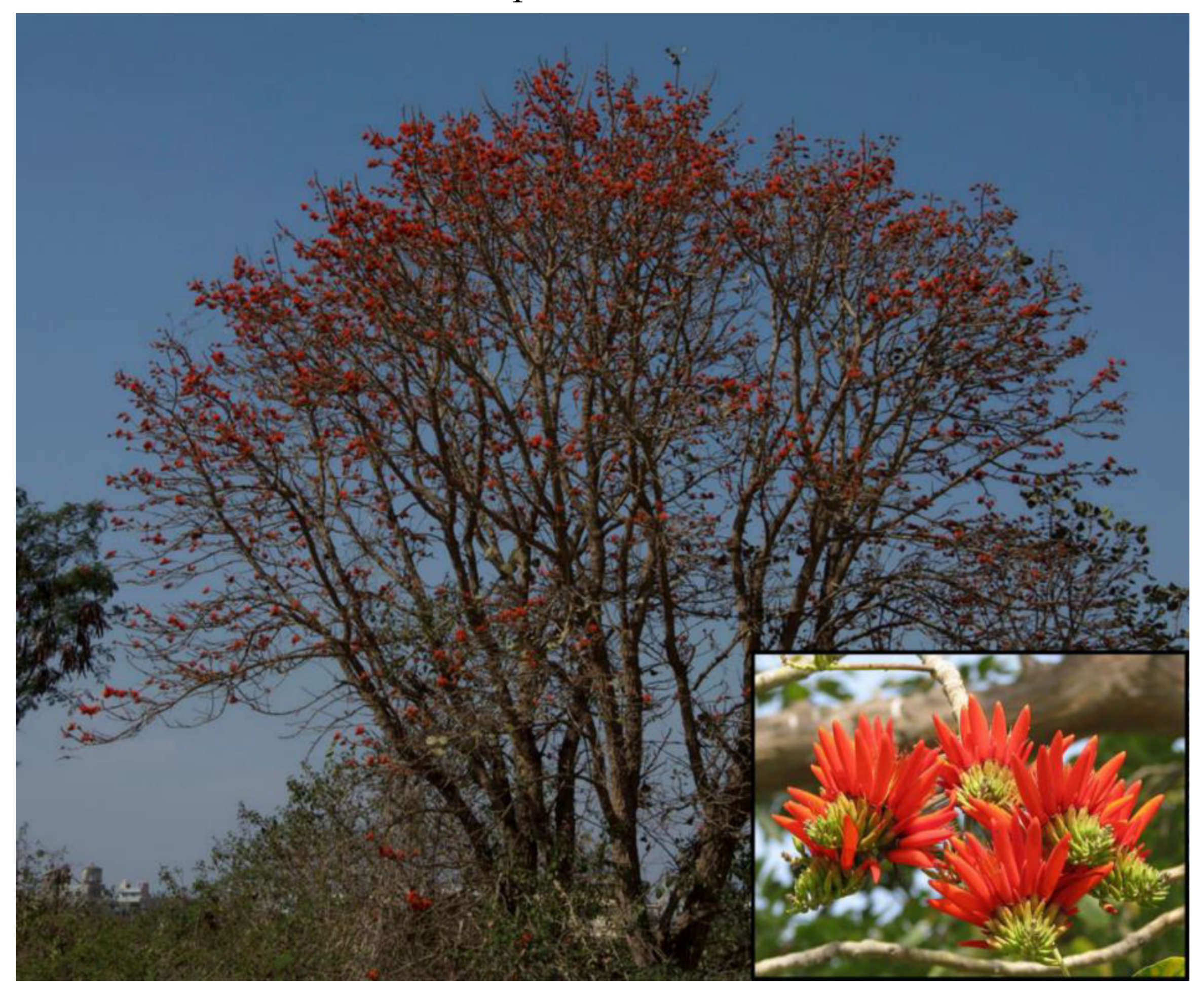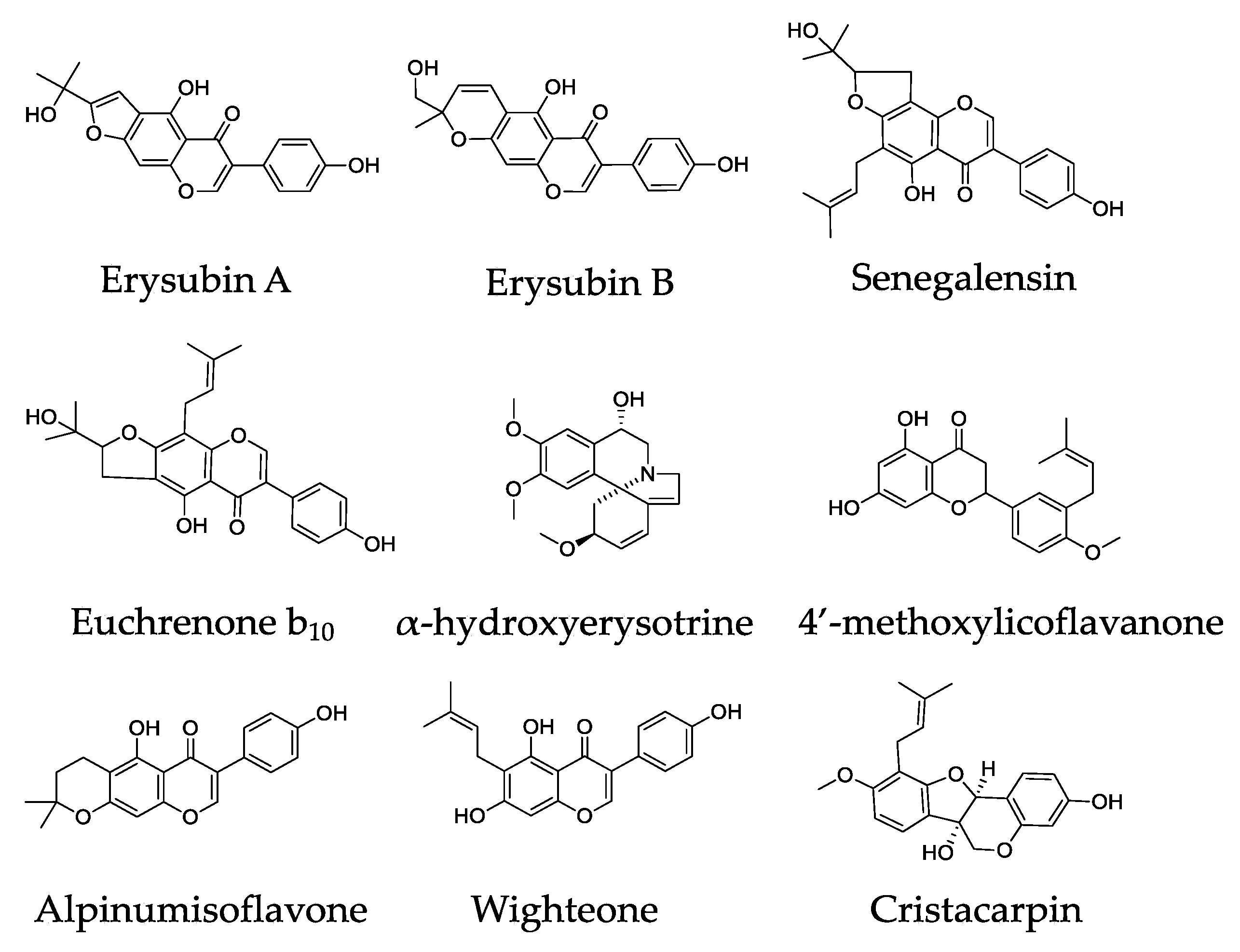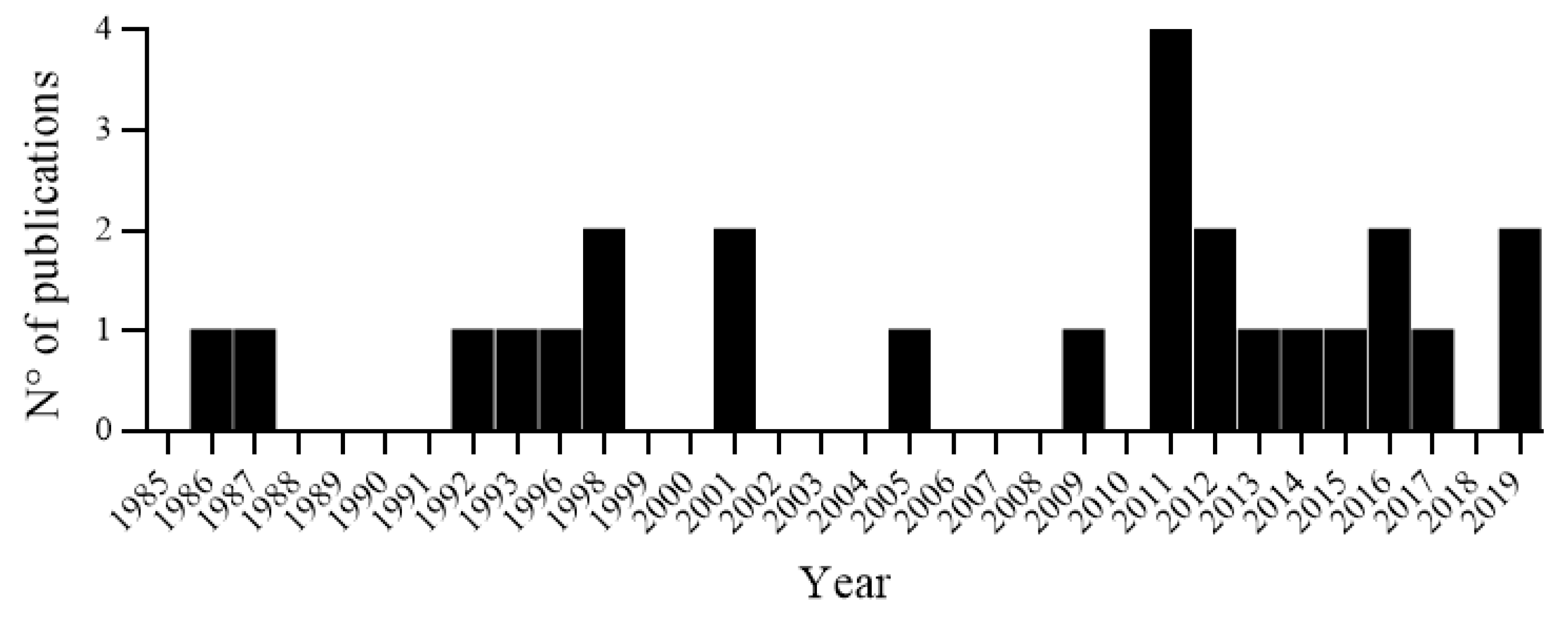Erythrina suberosa: Ethnopharmacology, Phytochemistry and Biological Activities
Abstract
1. Introduction
2. Taxonomy and Morphologic Description
3. Traditional and Common Uses
4. Bioactive Components and Phytoconstituents
5. Pharmacological Properties
6. Concluding Remarks
Author Contributions
Funding
Acknowledgments
Conflicts of Interest
References
- Chauhan, P.; Saxena, V.K. A New Prenylated Flavanone from Erythrina suberosa Roots. Planta Med. 1987, 53, 221–222. [Google Scholar] [CrossRef] [PubMed]
- Da Silva, M.M.B.; Santana, A.S.C.O.; Pimentel, R.M.M.; Silva, F.C.L.; Randau, C.P.; Soares, L.A.L. Anatomy of leaf and stem of Erythrina velutina. Rev. Bras. Farmacogn. Braz. J. Pharmacogn. 2013, 23, 200–206. [Google Scholar] [CrossRef]
- Kumar, S.; Pathania, A.S.; Saxena, A.K.; Vishwakarma, R.A.; Ali, A.; Bhushan, S. The anticancer potential of flavonoids isolated from the stem bark of Erythrina suberosa through induction of apoptosis and inhibition of STAT signaling pathway in human leukemia HL-60 cells. Chem. Biol. Interact. 2013, 205, 128–137. [Google Scholar] [CrossRef] [PubMed]
- EFLORAS. Available online: http://www.efloras.org/ (accessed on 11 November 2018).
- International Legume Database Information. Available online: http://www.ildis.org (accessed on 10 November 2018).
- Rambo, D.F.; Biegelmeyer, R.; Toson, N.S.B.; Dresch, R.R.; Moreno, P.R.H.; Henriques, A.T. The genus Erythrina L.: A review on its alkaloids, preclinical, and clinical studies. Phytother. Res. 2019, 33, 1258–1276. [Google Scholar] [CrossRef] [PubMed]
- Fahmy, N.M.; Al-Sayed, E.; El-Shazly, M.; Singab, A.N. Comprehensive review on flavonoids biological activities of Erythrina plant species. Ind. Crops Prod. 2018, 123, 500–538. [Google Scholar] [CrossRef]
- EOL. Encyclopedia of Life. Available online: http://eol.org/pages/643183/names/common_names (accessed on 10 November 2018).
- India Biodiversity Portal. Erythrina suberosa Roxb. Available online: http://indiabiodiversity.org/species/show/31297 (accessed on 9 November 2018).
- Kumar, A.; Lingadurai, S.; Jain, A.; Barman, N.R. Erythrina variegata Linn: A review on morphology, phytochemistry, and pharmacological aspects. Pharmacogn Rev. 2010, 4, 147–152. [Google Scholar] [CrossRef]
- Open_data_Keystone_Fundation. Flora of the Nilgiris. Available online: http://opendata.keystone-foundation.org/erythrina-suberosa-roxb (accessed on 9 November 2018).
- Serrano, M.A.R.; Batista, A.N.d.L.; Bolzani, V.d.S.; Santos, L.d.Á.; Nogueira, P.J.d.C.; Nunes-de-Souza, R.L.; Latif, A.; Arfan, M. Anxiolytic-like effects of erythrinian alkaloids from Erythrina suberosa. Quím. Nova 2011, 34, 808–811. [Google Scholar]
- Sanjappa, M. Legumes of India; Bishen Singh Mahendra Pal Singh: Uttarakhand, India, 1992. [Google Scholar]
- Khan, A.S. Medicinally Important Trees; Springer International Publishing: Berlin, Germany, 2017. [Google Scholar]
- Araújo-Júnior, J.X.d.; de Oliveira, M.S.G.; Aquino, P.G.V.; Alexandre-Moreira, M.S.; Sant’Ana, A.E.G. A Phytochemical and Ethnopharmacological Review of the Genus Erythrina; InTech: London, UK, 2012. [Google Scholar]
- Janbaz, K.H.; Nisar, U.; Ashraf, M.; Qadir, M.I. Spasmolytic, bronchodilatory and antioxidant activities of Erythrina superosa Roxb. Acta Poloniae Pharm. 2012, 69, 1111–1117. [Google Scholar]
- Khan, D.; Sahito, Z.A.; Javed Zaki, M.; Shahid Shaukat, S. Axial dimensions of pods and seeds and within-pod-allocation of phytomass and seed packaging cost in Erythrina suberosa Roxb. (Papilionaceae). Int. J. Bio. Biotechnol. 2014, 11, 191–206. [Google Scholar]
- Quattrocchi, U. CRC World Dictionary of Medicinal and Poisonous Plants: Common Names, Scientific Names, Eponyms, Synonyms, and Etymology; CRC Press: Boca Raton, FL, USA, 2016. [Google Scholar]
- Tanaka, H.T.T.; Etoh, H.; Watanabe, N.; Ahmad, M.; Qurashi, I.; Rehan Khan, M. Two New Isoflavones from Erythrina suberosa var. glabrescences. Heterocycles 1998, 48, 2669–2675. [Google Scholar] [CrossRef]
- Tanaka, H.; Doi, M.; Etoh, H.; Watanabe, N.; Shimizu, H.; Hirata, M.; Ahmad, M.; Qurashi, I.; Khan, M.R. Revised structures for senegalensin and euchrenone b (10). J. Nat. Prod. 2001, 64, 1336–1340. [Google Scholar] [CrossRef] [PubMed]
- Singh, H.; Chawla, A.S. Investigation of Erythrina spp. V. study of Erythrina suberosa leaves. Planta Med. 1971, 19, 378–379. [Google Scholar] [CrossRef] [PubMed]
- Singh, H.; Chawla, A.S. Erythrina sp. 3. Chemical constituents of Erythrina suberosa Roxb. seeds. J. Pharm. Sci. 1970, 59, 1179–1182. [Google Scholar] [CrossRef] [PubMed]
- Singh, H.; Chawla, A.S. Isolation of erysodine, erysotrine and hypaphorine from Erythrina suberosa Roxb. seeds. Experientia 1969, 25, 785. [Google Scholar] [CrossRef]
- Bhattacharyya, L.; Das, P.K.; Sen, A. Purification and properties of D-galactose-binding lectins from some Erythrina species: Comparison of properties of lectins from E. indica, E. arborescens, E. suberosa, and E. lithosperma. Arch. Biochem. Biophys. 1981, 211, 459–470. [Google Scholar] [CrossRef]
- Miana, G.A.; Ikram, M.; Sultana, F.; Khan, M.I. The isolation and characterization of erysotrine from the leaves of Erythrina suberosa. Lloydia 1972, 35, 92–93. [Google Scholar]
- Aye, M.M.; Aung, H.T.; Sein, M.M.; Armijos, C. A Review on the Phytochemistry, Medicinal Properties and Pharmacological Activities of 15 Selected Myanmar Medicinal Plants. Molecules 2019, 24, 293. [Google Scholar] [CrossRef]
- Dhar, M.L.; Dhar, M.M.; Dhawan, B.N.; Mehrotra, B.N.; Ray, C. Screening of Indian plants for biological activity: I. Indian J. Exp. Biol. 1968, 6, 232–247. [Google Scholar]
- Agrawal, S.K.; Agrawal, M.; Sharma, P.R.; Gupta, B.D.; Arora, S.; Saxena, A.K. Induction of apoptosis in human promyelocytic leukemia HL60 cells by an extract from Erythrina suberosa stem bark. Nutr. Cancer 2011, 63, 802–813. [Google Scholar] [CrossRef]
- Cao, Z.W.; Zeng, Q.; Pei, H.J.; Ren, L.D.; Bai, H.Z.; Na, R.N. HSP90 expression and its association with wighteone metabolite response in HER2-positive breast cancer cells. Oncol. Lett. 2016, 11, 3719–3722. [Google Scholar] [CrossRef][Green Version]
- Yin, Y.Z.; Wang, R.S.; Chen, R.D.; Qiao, L.R.; Yang, L.; Wang, C.M.; Dai, J.G. Chemical constituents from cell suspension cultures of Cudrania tricuspidata. J. Chin. Mat. Med. 2012, 37, 3734–3737. [Google Scholar]
- Wei, S.; Wu, W.; Ji, Z. New antifungal pyranoisoflavone from Ficus tikoua Bur. Int. J. Mol. Sci. 2012, 13, 7375–7382. [Google Scholar] [CrossRef] [PubMed]
- Akter, K.; Barnes, E.C.; Loa-Kum-Cheung, W.L.; Yin, P.; Kichu, M.; Brophy, J.J.; Barrow, R.A.; Imchen, I.; Vemulpad, S.R.; Jamie, J.F. Antimicrobial and antioxidant activity and chemical characterisation of Erythrina stricta Roxb. (Fabaceae). J. Ethnopharmacol. 2016, 185, 171–181. [Google Scholar] [CrossRef] [PubMed]
- Innok, P.; Rukachaisirikul, T.; Suksamrarn, A. Flavanoids and pterocarpans from the bark of Erythrina fusca. Chem. Pharm. Bull. 2009, 57, 993–996. [Google Scholar]
- Djiogue, S.; Halabalaki, M.; Alexi, X.; Njamen, D.; Fomum, Z.T.; Alexis, M.N.; Skaltsounis, A.L. Isoflavonoids from Erythrina poeppigiana: Evaluation of their binding affinity for the estrogen receptor. J. Nat. Prod. 2009, 72, 1603–1607. [Google Scholar] [CrossRef]
- Xiaoli, L.; Naili, W.; Sau, W.M.; Chen, A.S.; Xinsheng, Y. Four new isoflavonoids from the stem bark of Erythrina variegata. Chem. Pharm. Bull. 2006, 54, 570–573. [Google Scholar] [CrossRef]
- Chakraborty, S.; Rasool, R.U.; Kumar, S.; Nayak, D.; Rah, B.; Katoch, A.; Amin, H.; Ali, A.; Goswami, A. Cristacarpin promotes ER stress-mediated ROS generation leading to premature senescence by activation of p21waf−1. Age 2016, 38, 62. [Google Scholar] [CrossRef][Green Version]
- Tanaka, H.; Hattori, H.; Oh-Uchi, T.; Sato, M.; Sako, M.; Tateishi, Y.; Rizwani, G.H. Three new isoflavanones from Erythrina costaricensis. Nat. Prod. Res. 2009, 23, 1089–1094. [Google Scholar] [CrossRef]
- Tanaka, H.; Hattori, H.; Oh-Uchi, T.; Sato, M.; Yamaguchi, R.; Sako, M.; Tateishi, Y. Two new isoflavanones from Erythrina costaricensis. J. Asian Nat. Prod. Res. 2008, 10, 983–987. [Google Scholar] [CrossRef]
- Dagne, E.; Gunatilaka, A.A.; Kingston, D.G.; Alemu, M.; Hofmann, G.; Johnson, R.K. Two bioactive pterocarpans from Erythrina burana. J. Nat. Prod. 1993, 56, 1831–1834. [Google Scholar] [CrossRef]
- Mohanta, Y.K.; Panda, S.K.; Jayabalan, R.; Sharma, N.; Bastia, A.K.; Mohanta, T.K. Antimicrobial, Antioxidant and Cytotoxic Activity of Silver Nanoparticles Synthesized by Leaf Extract of Erythrina suberosa (Roxb.). Front. Mol. Biosci. 2017, 4, 14. [Google Scholar] [CrossRef] [PubMed]



© 2019 by the authors. Licensee MDPI, Basel, Switzerland. This article is an open access article distributed under the terms and conditions of the Creative Commons Attribution (CC BY) license (http://creativecommons.org/licenses/by/4.0/).
Share and Cite
Patti, F.; Taheri, Y.; Sharifi-Rad, J.; Martorell, M.; Cho, W.C.; Pezzani, R. Erythrina suberosa: Ethnopharmacology, Phytochemistry and Biological Activities. Medicines 2019, 6, 105. https://doi.org/10.3390/medicines6040105
Patti F, Taheri Y, Sharifi-Rad J, Martorell M, Cho WC, Pezzani R. Erythrina suberosa: Ethnopharmacology, Phytochemistry and Biological Activities. Medicines. 2019; 6(4):105. https://doi.org/10.3390/medicines6040105
Chicago/Turabian StylePatti, Felicia, Yasaman Taheri, Javad Sharifi-Rad, Miquel Martorell, William C. Cho, and Raffaele Pezzani. 2019. "Erythrina suberosa: Ethnopharmacology, Phytochemistry and Biological Activities" Medicines 6, no. 4: 105. https://doi.org/10.3390/medicines6040105
APA StylePatti, F., Taheri, Y., Sharifi-Rad, J., Martorell, M., Cho, W. C., & Pezzani, R. (2019). Erythrina suberosa: Ethnopharmacology, Phytochemistry and Biological Activities. Medicines, 6(4), 105. https://doi.org/10.3390/medicines6040105







